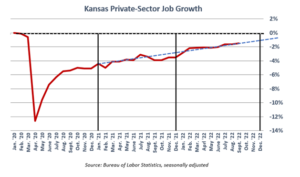September was another unexceptional month for Kansas’s jobs: the Sunflower State ranked in the bottom half nationwide for growth and is now in the minority of states that still haven’t fully recovered to pre-pandemic private-sector job numbers. Reducing the size of government and government workers is an opportunity to give Kansans more opportunity in the economy.
Kansas gained 1,600 private-sector jobs last month based on revised estimates for last month’s jobs numbers. The Bureau of Labor Statistics routinely updates its data with subsequent releases. If Kansas continues to grow at the same rate that it has since January 2021, the state will fully recover from its pandemic job losses sometime in 2023.
 The biggest gains occurred in the Accommodation and Food Services and Arts, Entertainment, and Recreation sectors which gained 1,300 and 1,100 jobs respectively. The broad BLS job category of “Other Services” gained 1,400 jobs and Health Care and Social Assistance industries gained 600 jobs. However, many of the other industries across the state lost jobs. Professional and Business Services lost 2,100 jobs, Financial Activities lost 500, Manufacturing lost 900, and Trade, Transportation, and Utilities lost 700.
The biggest gains occurred in the Accommodation and Food Services and Arts, Entertainment, and Recreation sectors which gained 1,300 and 1,100 jobs respectively. The broad BLS job category of “Other Services” gained 1,400 jobs and Health Care and Social Assistance industries gained 600 jobs. However, many of the other industries across the state lost jobs. Professional and Business Services lost 2,100 jobs, Financial Activities lost 500, Manufacturing lost 900, and Trade, Transportation, and Utilities lost 700.
The unemployment rate in Kansas went up to 2.6%, the highest it has been since January 2022. At the same time, the labor force participation rate declined in Kansas from 66.2% to 66.1%. The combination of these facts isn’t a good sign: it means that there are fewer people in the labor force and working jobs while the number of unemployed people has increased.
This month, Maine and New Hampshire joined the 25 other states that exceed their pre-pandemic job numbers – Kansas isn’t one of them. 32 states also had higher growth rates for jobs this month compared to Kansas.
Kansas lost 1,100 government jobs in September – 400 at the state level and 700 at the local level. Including federal jobs, there are 251,200 government workers in Kansas. And to the extent that the job losses are attributed to retirement and turnover, it’s good to see a decline in government workers.
U.S. Census data shows Kansas is the second-most-over-governed state in the country based on state and local government workers per capita. The state’s ratio of 698 government workers for every 10,000 citizens is the second highest in the country after Wyoming and is 37% above the national average.
More government employees means more spending, and more spending means more taxes that negative affect families and businesses. Government spending crowds out investment, displaces private-sector activity, and distorts the allocation and usage of resources in the market. More effective budgeting at the state and local level and consciously holding back the expansion of government gives people and businesses more room to prosper in the economy.





